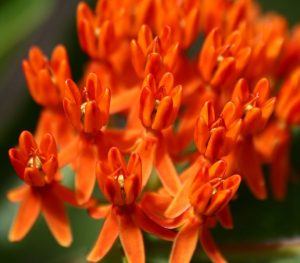 Asclepias tuberosa
Asclepias tuberosa
(ah-SKLEE-pee-us too-ber-OH-sah)
Family: Apocynaceae
Common name: butterfly weed, chieger flower, Indian paintbrush, pleurisy root, white root, windward root
Type: herbaceous perennial
Zone: 4 – 9
Height: 24-36 in (60-90 cm)
Spread: 18-24 (45-60 cm)
Aspect: full sun; part shade
Soil: moderate; poor; well-draining
Water: moderate; minimal
 Description: An herbaceous perennial with an erect, clumping habit and a long tap root. Narrow, lance-shaped leaves are green. Vibrant orange-red, umbel-like clusters of small, uniquely-shaped flowers appear atop hairy, milk-less stems in early summer through into autumn. (There can be some flower colour variations ranging from orange to yellow.) Spent flowers give way to 3-6 inch (7.5-15 cm) long, spindle-shaped seed pods which split open when ripe. The numerous, silky-tailed seeds are dispersed by the wind.
Description: An herbaceous perennial with an erect, clumping habit and a long tap root. Narrow, lance-shaped leaves are green. Vibrant orange-red, umbel-like clusters of small, uniquely-shaped flowers appear atop hairy, milk-less stems in early summer through into autumn. (There can be some flower colour variations ranging from orange to yellow.) Spent flowers give way to 3-6 inch (7.5-15 cm) long, spindle-shaped seed pods which split open when ripe. The numerous, silky-tailed seeds are dispersed by the wind.
Special Notes: Native to the eastern regions of North America, stretching to the western borders of Ontario, Minnesota, Iowa, and south to the Gulf of Mexico. One of very few Asclepias species which does not contain the typical milky sap found in other plants in the milkweed family, Apocynaceae. Because of this lack of toxic milky sap, this plant is the major food source for the Monarch and Victoria butterfly larvae. The flowers also lure other nectar-loving insects as each individual small flower produces copious amounts of sweet nectar.
Once upon a time, the dried root of this plant was used medicinally to treat pleurisy, an inflammation of the lungs.
Asclepias tuberosa has a long taproot which precludes its abhorrence to relocation. Best give its destination in your landscape design full consideration before placing it in the ground. If you really must move it, be sure to dig down deeply to ensure you get all of the taproot with the plant. Word to the wise…according to Allan M. Armitage in his book, co-authored with Judy M. Laushman, Specialty Cut Flowers: The Production of Annuals, Perennials, Bulbs, and Woody Plants for Fresh and Dried Cut Flowers (2008), “if you break the taproot when transplanting, it can take two years for the plant to recover, if ever”.
There are no serious insect or disease problems, although the leaves can be susceptible to rust and leaf spot. Of great note…this plant is deer and rabbit resistant. Also drought tolerant, once established.
Propagate by fresh seed in autumn. Seeds need stratification…a period of exposure to winter cold temperatures…of 0.5 – 3 °C (33-38 °F) for at least a month. If buying packaged seeds, place a few seeds (not the whole packet) in the refrigerator for 4 weeks…or in the freezer for 2 weeks…before sowing. Be patient. They may take longer than the typical 7 – 14 days to germinate.
In our Zone 7a garden: We used to have this plant in our garden. However, I suspect John moved this plant, as he is constantly tweaking his landscape design. Allan Armitage’s words of warning have a ring of authority to them because I fear John did not get all of the taproot when he embarked on its transplanting. We sadly no longer have Asclepias tuberosa in our garden.
But…if at first you don’t succeed…try, try again! I will keep you posted.
Posted on January 21, 2017; updated on September 10, 2024
